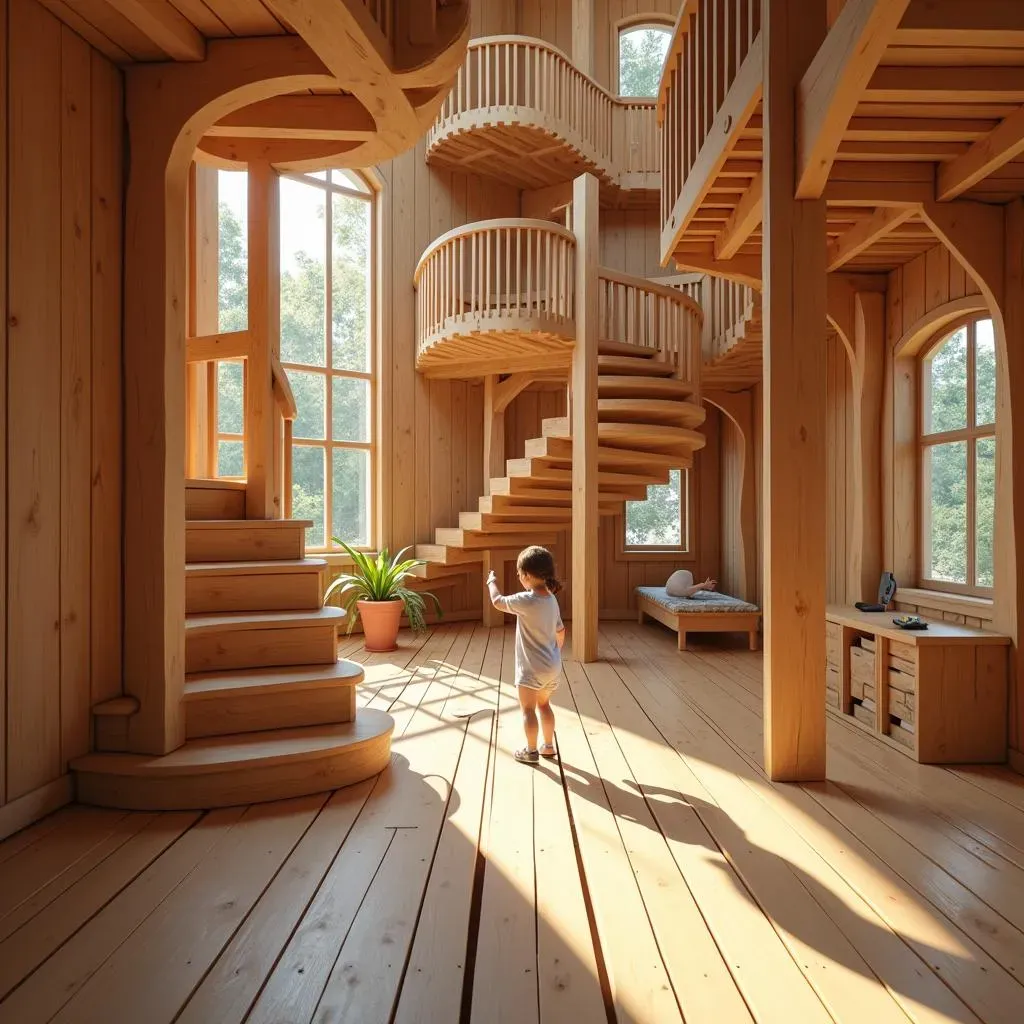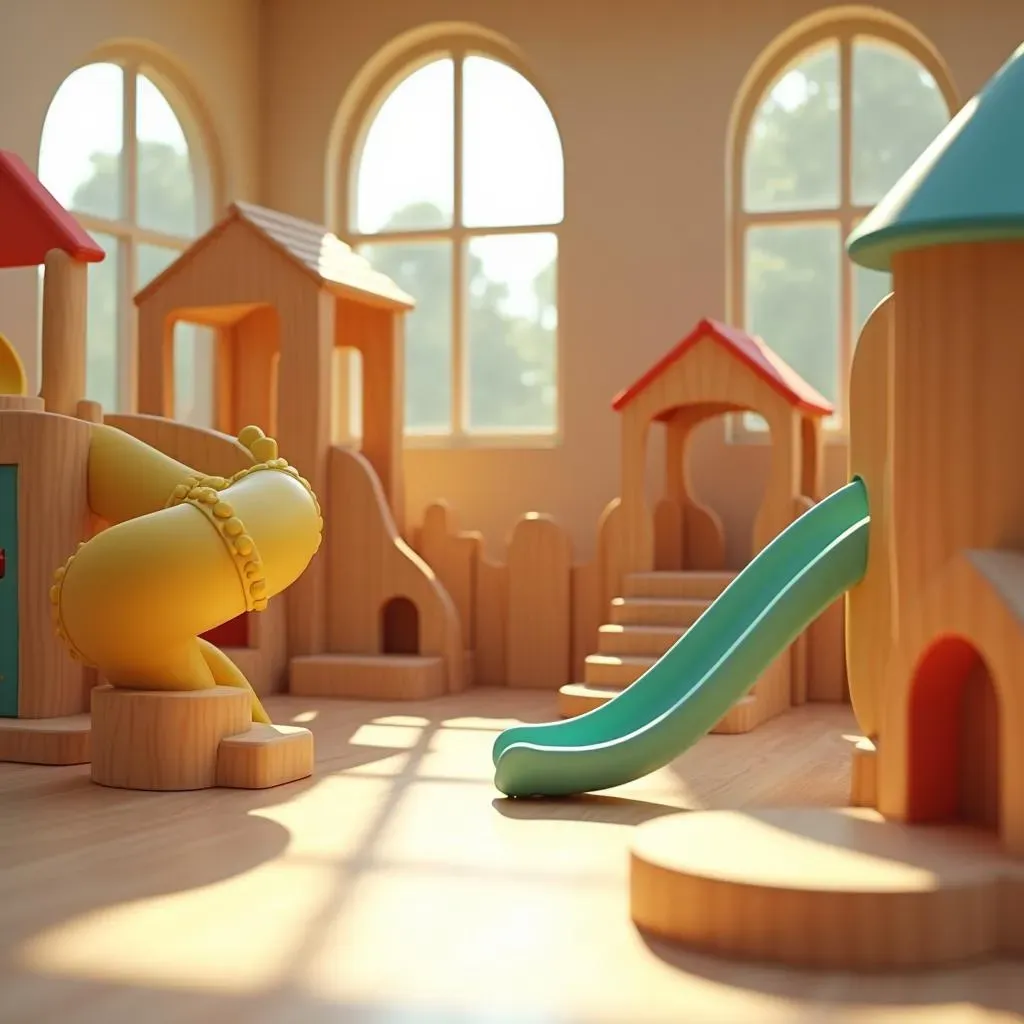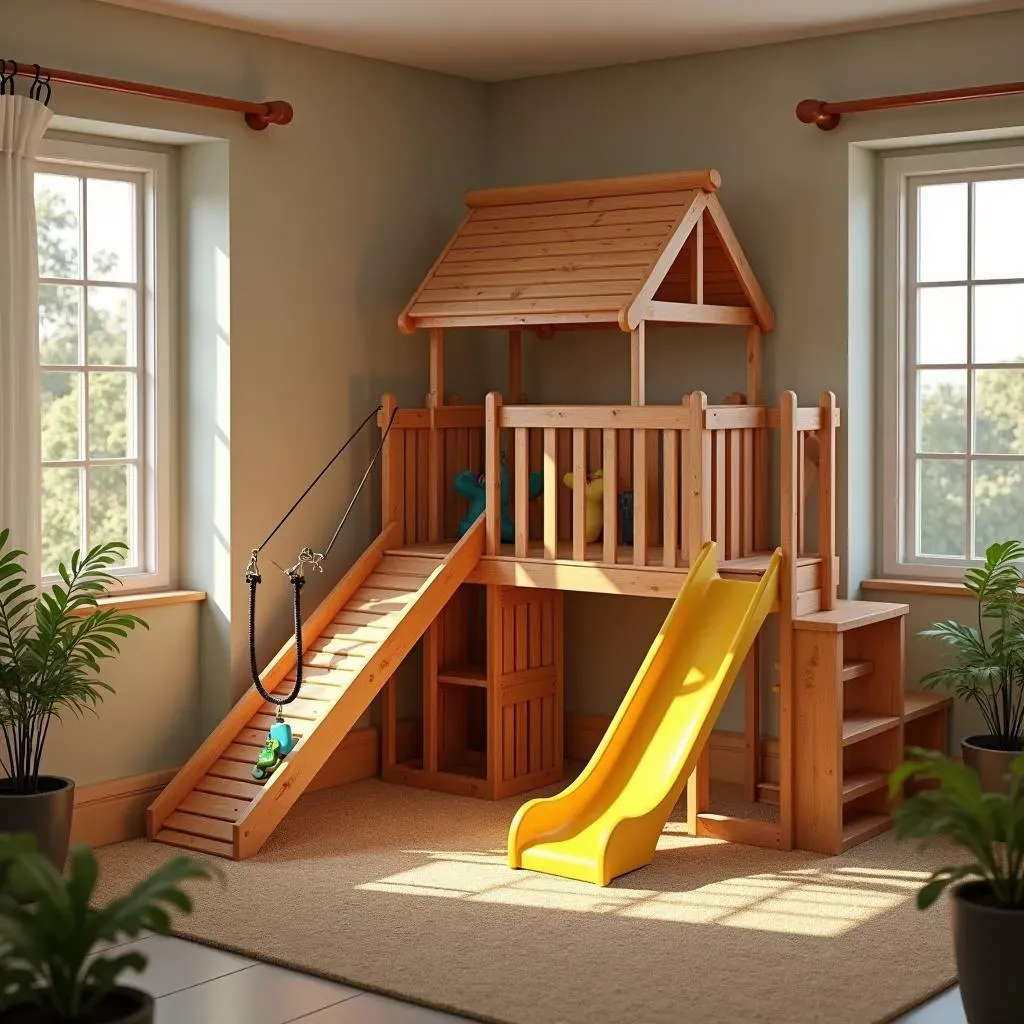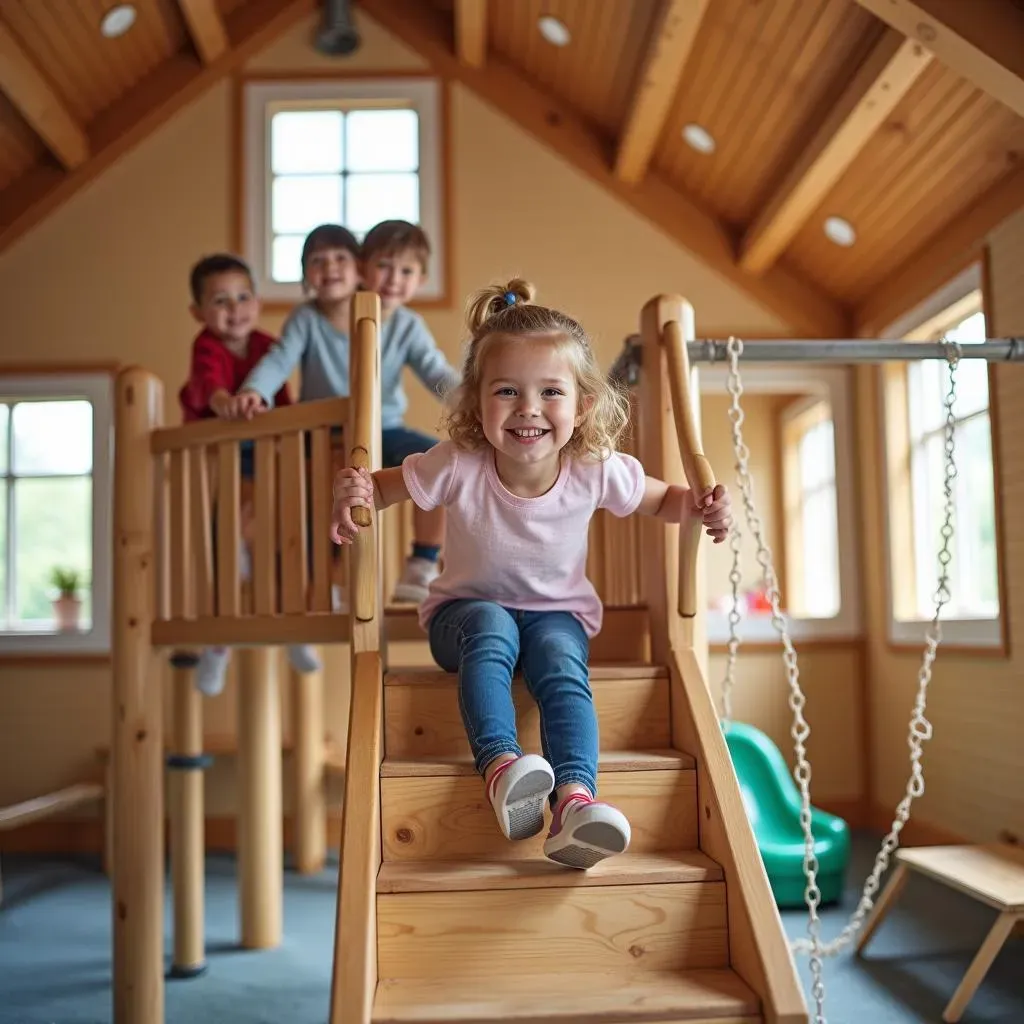Table of Contents
In a world dominated by screens, finding engaging and healthy activities for kids can feel like a never-ending quest. Enter the **wooden indoor playground**, a fantastic solution that brings the joy of outdoor play inside. Forget about rainy days or scorching heat limiting your children's fun; a wooden indoor playground offers a safe, creative, and active space for them to explore year-round. This article dives deep into the world of wooden indoor playgrounds, covering everything from their numerous benefits and design considerations to essential equipment and maintenance tips. We'll explore why wood is an excellent material choice, focusing on its durability, aesthetic appeal, and eco-friendliness. You'll learn how to design a playground that fits your space and budget, ensuring a safe and stimulating environment for your children. Ready to transform your home into a haven of fun and adventure? Let's explore the exciting possibilities of wooden indoor playgrounds and discover how they can enrich your children's lives.
Why Choose a Wooden Indoor Playground? Benefits and Advantages

Why Choose a Wooden Indoor Playground? Benefits and Advantages
Unleashing Creativity and Imagination
Wooden indoor playgrounds aren't just about physical activity; they're fertile grounds for sparking creativity and imagination. Unlike static toys or screen-based entertainment, a wooden playground encourages open-ended play. Children can create their own games, invent scenarios, and develop problem-solving skills as they navigate the different structures. Think of it as a blank canvas for their imaginations, fostering cognitive development in a fun and engaging way. They might pretend the climbing frame is a pirate ship, the slide is a waterfall, or the entire structure is a magical castle. The possibilities are endless, limited only by their creativity.
Safety First: A Natural and Secure Play Space
When it comes to our kids, safety is paramount, right? That's where wooden indoor playgrounds truly shine. Wood, especially when properly treated and maintained, offers a naturally sturdy and secure play environment. Compared to plastic or metal alternatives, wood is less likely to splinter or shatter, reducing the risk of injuries. Plus, the natural texture of wood provides better grip for little hands and feet, minimizing slips and falls. It's a win-win: a safe space for kids to explore and parents to breathe a little easier. Opting for non-toxic finishes and ensuring regular inspections are key to maintaining this safe haven.
Durability, Sustainability, and Aesthetic Appeal
Let's face it, kids can be tough on toys, but a well-built wooden indoor playground is designed to withstand years of energetic play. Wood is a naturally durable material, capable of handling the wear and tear of daily use. Furthermore, choosing a wooden playground is an environmentally conscious decision. Wood is a renewable resource, and many manufacturers use sustainably sourced timber, minimizing the environmental impact. Beyond its practical benefits, wood also adds a touch of natural beauty to your home. Its warm tones and classic aesthetic blend seamlessly with any decor, creating a play space that's both functional and visually appealing.
Key Advantages of Wooden Indoor Playgrounds:
- Enhanced Creativity: Encourages imaginative play and cognitive development.
- Superior Safety: Offers a naturally sturdy and secure play environment.
- Long-lasting Durability: Built to withstand years of energetic play.
- Eco-Friendly Choice: Made from renewable and sustainable materials.
- Aesthetic Appeal: Adds a touch of natural beauty to your home.
Designing Your Dream Wooden Indoor Playground: Space, Safety, and Style

Designing Your Dream Wooden Indoor Playground: Space, Safety, and Style
Alright, so you're ready to dive into designing your own wooden indoor playground? Awesome! First things first, let's talk space. It's not just about how much room you have, but how you use it. Think vertical! Climbing structures and multi-level platforms can maximize a smaller footprint. Before you even start sketching, measure your space carefully, noting any obstacles like windows, doors, or support beams. Then, consider the flow. You want kids to be able to move freely and safely between different activities. Avoid creating dead ends or cramped corners. Proper planning is key to a successful and enjoyable play area.
Next up: safety. This isn't just an afterthought; it's baked into the entire design process. Start with the flooring. You'll want a soft, impact-absorbing surface like rubber mats or padded carpeting to cushion any falls. Then, think about fall zones. Ensure there's ample clear space around climbing structures and slides. All wooden surfaces should be smooth, sanded, and free of splinters. Use non-toxic paints and finishes to avoid any harmful chemicals. Regular inspections are crucial, too. Keep an eye out for loose screws, worn-out parts, or any other potential hazards. A little preventative maintenance goes a long way in keeping your kids safe.
Finally, let's talk style! Your wooden indoor playground doesn't have to be an eyesore. It can be a beautiful and integrated part of your home. Consider the overall aesthetic of your space and choose a design that complements it. Natural wood tones are always a safe bet, but you can also add pops of color with paint or fabric. Think about incorporating elements that reflect your children's interests and personalities. A climbing wall for your little adventurer, a cozy reading nook for your bookworm, or a mini stage for your budding performer. The possibilities are endless. Ultimately, the goal is to create a space that's both functional and visually appealing, a place where your kids can play, learn, and grow in style.
Design Element | Considerations |
|---|---|
Space | Measure carefully, think vertical, consider flow. |
Safety | Impact-absorbing flooring, fall zones, smooth surfaces, non-toxic finishes. |
Style | Complement your home's aesthetic, incorporate your children's interests. |
Wooden Indoor Playground Equipment: From Swings to Slides and More

Wooden Indoor Playground Equipment: From Swings to Slides and More
Swinging into Fun: The Classic Swing Set
No wooden indoor playground is complete without a swing set! It's a timeless classic that provides endless hours of entertainment for kids of all ages. When choosing a swing set for your indoor playground, consider the available space and the height of your ceiling. There are various types of swings to choose from, including traditional belt swings, tire swings, and even trapeze bars for more adventurous kids. Safety is key, so ensure the swing set is securely anchored to the floor or ceiling and that there's ample space around the swings to prevent collisions. Adding soft padding underneath the swings is also a good idea to cushion any falls. A swing set is more than just a piece of equipment; it's a gateway to carefree fun and laughter.
Sliding into Adventure: The Thrill of the Slide
What's a playground without a slide? Slides are another essential element of any wooden indoor playground, offering a thrilling ride and promoting physical activity. Wooden slides are a popular choice for indoor playgrounds due to their natural aesthetic and smooth surface. Consider the age and skill level of your children when selecting a slide. Younger children might prefer a shorter, gentler slide, while older kids might enjoy a taller, more challenging one. Ensure the slide has high sides to prevent falls and a soft landing area at the bottom. Slides can be incorporated into various playground designs, such as connecting them to climbing structures or platforms. A slide adds an element of excitement and adventure to your wooden indoor playground, making it a place where kids can burn off energy and have a blast.
Maintaining Your Wooden Indoor Playground: Keeping the Fun Alive

Maintaining Your Wooden Indoor Playground: Keeping the Fun Alive
Alright, you've invested in a fantastic wooden indoor playground, now let's talk about keeping it in tip-top shape! Regular maintenance is key to ensuring its longevity, safety, and continued enjoyment. Think of it like this: a little TLC goes a long way in preventing bigger problems down the road. We're talking about creating a safe and hygienic environment for your kids to play in, year after year. So, what does maintaining your wooden indoor playground actually involve? Let's break it down into simple, manageable steps that anyone can follow.
First things first: regular cleaning. This isn't just about wiping down surfaces; it's about removing dirt, grime, and potential allergens that can accumulate over time. Use a mild soap and water solution to clean all wooden surfaces, avoiding harsh chemicals or abrasive cleaners that can damage the finish. Pay special attention to high-touch areas like handrails, swing seats, and slide surfaces. For stubborn stains or sticky spots, try a mixture of baking soda and water. Remember to dry everything thoroughly after cleaning to prevent moisture damage. A clean playground is a happy playground! Aim for at least weekly cleaning, or more frequently if needed, depending on how much use it gets.
Next up, inspections! Regular inspections are crucial for identifying and addressing potential safety hazards before they become a problem. Check for loose screws, splinters, cracks, or any other signs of wear and tear. Pay close attention to joints, connections, and anchoring points. Tighten any loose screws or bolts, and replace any damaged parts immediately. Sand down any splinters or rough edges to prevent injuries. If you notice any structural damage, consult a professional to assess the situation and make necessary repairs. A thorough inspection should be conducted at least once a month, or more frequently if the playground is heavily used. Remember, safety first!
Finally, let's talk about protecting the wood. Applying a sealant or finish can help protect the wood from moisture, UV damage, and wear and tear. Choose a non-toxic, child-safe sealant that's specifically designed for outdoor use. Follow the manufacturer's instructions carefully when applying the sealant. Reapply the sealant every year or two, or as needed, depending on the climate and the amount of use the playground receives. You can also use a wood preservative to protect the wood from rot and decay. By taking these steps, you can help extend the life of your wooden indoor playground and keep it looking its best for years to come.
Maintenance Task | Frequency | Tools/Materials |
|---|---|---|
Cleaning | Weekly | Mild soap, water, soft cloths |
Inspections | Monthly | Screwdriver, wrench, sandpaper |
Sealing/Finishing | Annually/Bi-annually | Non-toxic sealant, brush |
Conclusion: Building a World of Play with Wooden Indoor Playgrounds
Investing in a wooden indoor playground is more than just buying equipment; it's creating a space for imagination, physical activity, and lasting memories. By carefully considering design, safety, and maintenance, you can build a playground that grows with your children, providing endless hours of fun and development. So, embrace the warmth and versatility of wood, unleash your creativity, and transform your home into a haven where play knows no bounds. The joy and well-being of your children are worth every effort, making a wooden indoor playground a truly valuable addition to your family life.